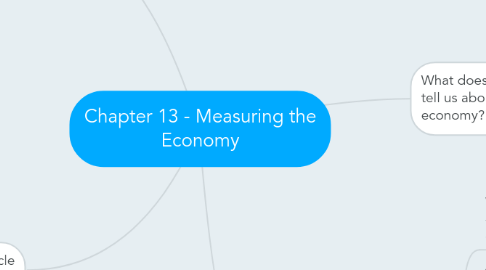Chapter 13 - Measuring the Economy
William Robertsにより

1. How do economists measure the economy?
1.1. Gross Domestic Product (GDP): What an economy produces
1.2. Measuring the GDP: C (Household Consumption)+I (Business Investment)+G (Government purchases)+Xn (Net of exports minus imports)=GDP
1.3. Nominal vs. Real GDP: What's the difference? Nominal GDP is measured taking the difference of the previous year's economy and the year following. So if I had $3 last year and $5 this year my personal economy grew by $2. Real GDP takes inflation into account and measures and economy in constant dollars which is a fixed dollar amount that does not change. Real GDP can measure an economy more accurately.
1.4. Constant Dollars: Fixed rate that was current in a specified base year.
1.5. Net Exports: The value of all exports minus imports
2. How does the business cycle relate to economic health?
2.1. Four phases of the business cycle: Expansion, Peak, Trough, and Contraction (Not in that order)
2.2. Economic Indicators: Lagging, Leading, Coincident.
2.3. Expansion- Economic Growth
2.4. Peak- Expansion ends
2.5. Trough- Lowest point of contraction
2.6. Contraction- Period of economic decline
3. What does the unemployment rate tell us about the health of the economy?
3.1. Measuring the unemployment rate: Before even determining how the unemployment rate reflects the health of the economy, we must first understand how unemployment is measured. First, there are 3 categories of employment, those who are employed, those who are unemployed and looking for work, and those who are unemployed and not looking for work. After breaking up the population into these 3 categories we can begin to measure the unemployment rate. Represented as an equation, unemployment rate is determined by dividing the # of unemployed people by the # of employed people, multiply by 100 then shazam there you go. That's your unemployment rate.Measuring the unemployment rate: Before even determining how the unemployment rate reflects the health of the economy, we must first understand how unemployment is measured. First, there are 3 categories of employment, those who are employed, those who are unemployed and looking for work, and those who are unemployed and not looking for work. After breaking up the population into these 3 categories we can begin to measure the unemployment rate. Represented as an equation, unemployment rate is determined by dividing the # of unemployed people by the # of employed people, multiply by 100 then shazam there you go. That's your unemployment rate.
3.2. 4 types of unemployment: Frictional, Seasonal, Cyclical, and Structural.
3.3. Economic Cost of High Unemployment: High unemployment rates mean that there are less workers in the labor force, which means less labor and lost potential products and goods.
3.4. Seasonal Unemployment: Occurs when a business shuts down or runs slowly for a part of the year.
3.5. Cyclical Unemployment: Caused by the flucuation of the economy
3.6. Structural Unemployment: When the job required is replaced by something else like a robot.
3.7. Frictional Unemployment: When someone is seeking employment after just previously leaving a prior position they held. Or for people looking for their first job.
4. What does the inflation rate reveal about an economy's health?
4.1. What does the consumer price index do? The CPI measures a "market basket" of what consumers purchase. This market basket shows the prices and changes of goods.
4.2. Adjusting for inflation: Is the $3 gallon of milk any more valuable than a $0.05 gallon of milk over 70 years ago? No, in fact they are worth the same, but with different prices.
4.3. Understanding Creeping inflation, Hyperinflation, and deflation: Creeping inflation is what most first world countries might experience, a slowly rising inflation average about 2.5% each year. Hyperinflation, which may most accurately be described as inflation on steroids, but occurs when a government loses control of the economy and the inflation rate skyrockets. Deflation, which is the opposite of inflation is when the value of the dollar decreases.
4.4. Inflation Rate: The percentage increase in the average price level of goods and services from one month or year to the next.
4.5. Wage-Price spiral: When employees demand higher wages, and employers increase their working wages but also increase product price.
4.6. An article to help explain how the consumer price index works http://econpage.com/202/handouts/CPI-handout.html


